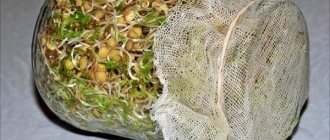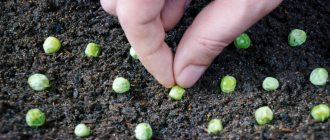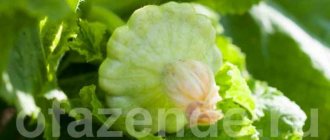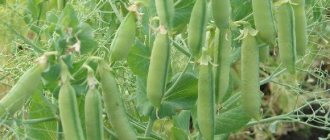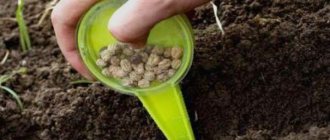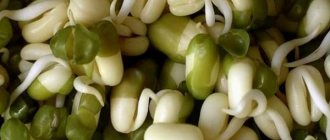Peas are a common annual fruit crop among gardeners, valued for their good yield, excellent delicate taste of the fruit and excellent health benefits. To get a good harvest from your garden plot, you need not only to properly care for the plants, but also to pre-soak and germinate the peas before planting.
Why are peas sprouted?
Peas have a thick, dense shell, which, once in the frozen ground, slowly breaks out in the spring with sprouts and emerging roots. Therefore, in order to get an excellent harvest, and for the plantings to quickly sprout in the garden, experienced gardeners recommend pre-germinating peas one day at a time, especially since such a procedure is not difficult. On the Internet you can read how to germinate chickpeas or other varieties of this crop.
Gardeners recommend soaking peas for the following purposes:
- when germinating seeds for food;
- for their subsequent planting in the beds.
For seed germination, the simplest conditions are necessary, so even novice gardeners can handle this procedure correctly. But by planting this crop in the beds without first soaking and sprouting the peas, we invariably worsen the yield indicators, while the appearance of the first shoots can be expected for a month or more.
Germination for planting in the garden
The key to getting a good harvest in the garden will be the use of high-quality planting material, which is sorted, then properly soaked and germinated. Also, gardeners with more than 10 years of experience recommend pre-treating planting material with a nitrogen-fixing inoculant. The agrochemical necessary for germination can be easily purchased in most specialized stores; however, you should act solely according to the instructions on the packaging of the drug, which tells you whether such a chemical can be used and how to prepare a solution for treatment.
Direct germination of pea seeds before planting is carried out using the following technology:
- Peas treated in the inoculant should be distributed on a paper towel, which is folded four times and moistened generously.
- A wet, folded towel is placed in a perforated plastic bag, which is lightly tied with an elastic band or the neck is tied in a knot.
- The bag with seeds is placed in a warm, well-lit place with sunshine with a temperature of 18-20 degrees.
- From time to time, you should moisten the bag and paper towels using a spray bottle.
- As soon as the first barely noticeable 1-2 mm roots appear, you can carefully plant them in the garden in beds or small pots.
The technology of growing peas at home is popular, for which the sprouted seeds are carefully planted in flower pots with fertile soil purchased or prepared independently. All that needs to be done next is to arrange a small suspension for the growth and development of this climbing plant.
How to plant peas on the balcony
If the apartment owner has a glassed-in balcony, he can arrange a mini-garden on it and grow various crops, harvesting several vegetable crops a year. You can grow vegetables on an open balcony until frost sets in; you cannot allow the soil to freeze and the greens and grains to freeze. For peas, you need to choose a well-lit area of the loggia.
He will feel more comfortable in the glassed-in loggia. And on the windowsill it can produce a harvest more than once a year, provided that the plant has enough light and moisture. If there is little light, it is recommended to place a fluorescent lamp nearby.
Seed preparation
Only select peas that are ripe, undamaged, without chips, and not old. You can select the seeds correctly by first placing the workpiece in salted water. To do this, place the peas in a saline solution (take a spoonful of salt per 1000 ml of warm water).
Those grains that are suitable for planting will immediately fall to the bottom and will not float up again. Only these healthy seeds are allowed to be planted. Those not suitable for planting will float on the surface of the solution.
Next, begin preparing the seeds selected for planting:
- Selected peas need to be prepared for sowing. They need to be disinfected to protect them from diseases and all kinds of pests.
- To do this, they need to be poured into a 2% solution of potassium permanganate for at least 20 minutes.
- After the grain, you need to plant it in the soil or pre-germinate it - leave it in a damp towel until sprouts appear from the grains. This procedure can be carried out at will. Sprouted grains will sprout faster, the peas will be more nutritious, and the harvest will be plentiful.
Sprouted seeds require frequent and good watering. Those planted dry will germinate gradually, receiving moisture from the soil. They will sprout a week later than germinated ones.
You can germinate peas on a damp cloth:
- First, soak it in warm water to swell it.
- Pour water over the peas just above the grains and let stand for 12-15 hours. They should absorb most of the water.
- Then pour the seeds into a piece of cloth. Make sure it is constantly moist, otherwise the seeds will die. But do not water them too much, otherwise they will rot. It is enough to spray from a spray bottle.
- Seedlings will appear in 3-5 days.
- You can plant seeds when the length of the sprouts is 2 times the diameter of the peas.
First, peas need to be sown in small containers made of wood or plastic. After the second full-fledged leaf appears on the sprout, they need to be planted in a larger container, that is, dived.
Soil preparation
Soil for growing is taken from the garden. It is not recommended to collect it in a place where legumes were previously grown. More suitable land where there was pumpkin or nightshade. Suitable soil can also be purchased at a specialized store. It will be good if you add leavening agents in the form of humus, sawdust, straw, small pebbles or sand. Peas need loose, moist and alkaline soil. Before sowing the seeds, it must be well moistened with water.
You can take the soil from your dacha.
The soil taken from the garden should be treated against fungus and insect pests. You should add mineral fertilizers to it by mixing them with the water prepared to moisten the soil.
How to plant selected grains
Draw grooves in the soil, the width between them should be 3-5 cm. Peas should be planted to a depth of 4 cm and distanced from the neighbor by 2-3 cm.
If you plant with sprouts, when two leaves form, you need to plant them in different pots with a volume of 300 ml or more or spacious boxes. It is recommended to plant them at a distance of 5 cm, and make an interval of at least 10 cm between the grooves. You need to replant the sprout with a lump of earth on the rhizome, deepening it by 5 cm.
Planting vegetable crops has its own tricks.
Sprouting for food
Peas are a protein- and fiber-rich food that will be especially beneficial after sprouting the pea seeds for a short time in clean water. Regular consumption of such peas not only strengthens the body, but also helps with pancreatitis, gastritis, diabetes and other diseases. It usually takes a few days for pea seeds to germinate.
Step-by-step instruction:
- The peas are washed for 2-3 minutes under warm water in a colander. Next, you will need a plastic container, pour peas into it, level it along the bottom, and then fill it with water, the level of which should be 1 centimeter above the seeds.
- The container is closed with a lid, which should have several holes for ventilation. The primary germination of bean seeds usually takes 14 hours, after which the container is opened, the old water is drained, the peas are washed, and they are put back into the container, filled with fresh water and left for a day.
- Immediately after the appearance of small roots of sprouts; The peas are carefully washed again in water, after which they are eaten or sent to the refrigerator, where they can be stored for several days.
Growing peas on the balcony
There are non-standard ways to grow vegetables on the balcony. They are used due to the lack of sufficient space.
In plastic bottles
To save materials for making containers for planting, you can use plastic bottles with a capacity of 1.5-2 liters. They are used to make a hanging vegetable garden on the loggia, which will significantly save room space.
How to make containers:
- Wash the bottle and cut a rectangular hole on the side, and drill several small holes on the other side for drainage.
- Pour soil into the bottle and you can plant peas.
- To hang the container, you need to make a hole in the bottom of the bottle for tying a rope, and on the other side you can tie it by the neck.
- Make a support in the form of a net for all hanging containers or allow the stems to hang freely.
Plastic bottles can be installed or hung vertically. In the top of the bottle, cut holes around the entire perimeter. They need to be made as large as possible so that the stems can come out of them freely. Next, it’s enough to plant the grain in the ground and grow the peas as usual.
If you hang the bottles, then you do not need to build a support, the stems will hang freely, and will not only supply the whole family with green peas, but also decorate the interior of the balcony with their appearance.
In pots
Pots for growing vegetables on the loggia must be quite spacious, with a minimum volume of 300 ml. Peas are often grown from seedlings in pots. When the time comes to plant the seedlings, you need to plant them in small pots. Peas grow and develop perfectly in them.
For planting, the following manipulations should be carried out:
- Treat the pots with boiling water.
- Fill them with soil, digging a hole in the middle the size of the rhizome of the sprout.
- Place the seedlings in a hole, straighten the roots and cover with soil.
- There is no need to compact the soil. Add a little water and place in a shaded place. In order for the sprouts to take root, excessive light is harmful to them.
When the sprouts grow, it is necessary to provide support for the stems. It can be built from a wooden peg or string next to the pot. You can install a plastic mesh.
The best varieties
Today in gardening stores you can find dozens, if not hundreds of different varieties that differ in the taste of the harvest and the growing season. Early ripening hybrids can be harvested within 50-55 days after emergence. But in late varieties the growing season can reach 90 days.
The following types are considered the best varieties:
- Pharaoh.
- Prelado.
- Oscar.
- Faith.
- Moscow delicacy.
Low-growing varieties with a plant stem height of 40-50 centimeters are excellent for growing peas at home. These include Vera, Caledonian miracle, early ripening Alpha. Most of these species are hybrids; they do not retain their grade indicators, so harvesting seeds yourself will be problematic.
It is also customary to distinguish shelling varieties, which are distinguished by hard and rough pods. Such peas are characterized by high calorie content and high starch content. Peas grown in the garden from shelling varieties will be excellent for making soups and porridges. The best peeling varieties include Alpha, Avola, Viola, Karina f1, and Voronezh green.
Growing at home
You can grow peas with equal success both in the garden beds and on the windowsill. In the latter case, it is necessary to select low-growing varieties that will not be difficult to care for. You will need to set up an improvised trellis along which this plant will climb, rising higher and higher, and on the side layers, literally a month and a half after the emergence of seedlings, pods with sweet peas will begin to form.
A prerequisite for growing peas at home will be the use of fertile soil, abundant and regular watering, sufficient lighting and proper seed preparation. By providing such simple care for your plantings, you can get fresh peas even in winter, and the plants can bear fruit constantly, supplying the whole family with tasty and healthy vegetables. You can easily set up a full-fledged garden bed on the windowsill, caring for which is not particularly difficult. On the Internet you can find thematic videos telling how to plant peas at home.
Planting peas in a greenhouse
To grow super early crops, peas are sometimes planted in a greenhouse. Although, of course, a thrifty owner would rather spend precious space growing more heat-loving crops. In unheated greenhouses, including polycarbonate ones, sowing is carried out in March. Only sugar brain varieties are planted in greenhouses, the pods of which you want to enjoy as early as possible.
Of course, there’s not a lot of space in the greenhouse for peas, but ardent lovers will definitely plant a few bushes
Greenhouse growing of peas is no different from ordinary cultivation, except that with the onset of warm weather the greenhouse will have to be constantly ventilated: peas do not like heat. In addition, due to high humidity, peas in a greenhouse often develop powdery mildew. They plant peas in the same way as they do in unprotected soil, but do not rely on rain and water more often. To repel pests, mustard is sown nearby or pre-grown basil seedlings are planted.
Growing in the garden
After soaking, the peas are planted in rows in the garden bed, the distance between each plant should be at least three centimeters. The planting depth is 3-4 centimeters. The bed is prepared in the fall by adding a small amount of organic fertilizer to the soil, and in the spring, nitrogen, potassium and calcium are added to the soil a few weeks before planting. You can also use wood ash, which is a natural and environmentally friendly source of nitrogen and other beneficial microelements.
Caring for plantings in the garden is not difficult; plants need periodic loosening of the soil and removal of weeds, abundant watering and timely harvesting. It will be necessary to additionally arrange supports for climbing growing shoots by tying up young plants and not allowing them to spread along the ground. To get an excellent harvest on your personal plot, you need to feed the peas and treat the plants to prevent pests and diseases.
Peas should be watered exclusively with settled water at least once a week. The soil should not be allowed to dry out, as in this case the taste of the grown crop will significantly deteriorate. During the flowering period, the frequency of watering is increased, irrigating the plants four times a week. It is also recommended to feed peas with mineral compounds that contain phosphorus, potassium and copper. You can prepare such fertilizers yourself by dissolving 15 grams of potassium salt and 15 grams of superphosphate in a bucket of water. You just need to take into account how much fertilizer was used during planting and, depending on this, adjust the dose of fertilizing.
Harvesting usually begins a month after flowering ends. The pods ripen in batches over one and a half to two months. It is best to harvest in the morning every 1-2 days. If appropriate conditions are provided, about half a kilogram of protein and fiber-rich peas can be harvested from each bush.
Planting peas in open ground
Peas are a cold-resistant crop; seedlings can withstand frosts down to -6 °C. In early spring, they begin to sow peas as the soil dries, but not earlier than April 20.
In summer, peas can be sown until mid-July (early ripening varieties).
Before sowing, pea seeds can be soaked in cold water for 12 hours (change the water every 2 hours) or sown dry in open ground.
Dry seeds are heated for 5 minutes in a hot solution (40 degrees) of boric acid (2 g of acid per 10 liters of water). This pre-sowing treatment reduces the likelihood of peas being damaged by the nodule weevil larva.
Sowing seeds:
80-130 seeds are sown per 1 m2 of plot.
Important: pea seeds remain viable for 2 years. The technology for sowing peas in open ground is as follows: The technology for sowing peas in open ground is as follows:
The technology for sowing peas in open ground is as follows:
- use a flat hoe to make a furrow 15-20 cm wide, 50 cm distant, 5 cm deep - distribute the peas into the ground at a distance of 5 cm from each other - cover the top with soil, compacting it well.
Shoots usually appear 6-15 days after sowing.
You will have young peas all season, sowing the seeds at intervals of 14 days.
Pea care
Caring for peas is not difficult - the main thing is to do weeding, watering, and harvesting on time.
Once sprouts emerge, the sprouts need protection from birds - cover the sprouts with a regular fishing net.
Peas are a moisture-loving plant and require abundant watering; they do not tolerate heat. Watering should be sufficient in dry weather - 9 liters of water per 1 m2 of area.
Try to combine watering with fertilizing the peas (1 tablespoon of nitroammofoska per 10 liters of water), mulch the soil after watering.
Do not forget, especially during the initial period of pea growth, to loosen the soil and hill up the plants.
Pea bushes need support made of wire or mesh, stretched and secured to pegs driven into the ground next to the plants.
Pea harvest
30-60 days after sowing the seeds, the peas bloom and the flowers are self-pollinated. Approximately 1 month after flowering, harvesting begins. The fruiting period of peas lasts 33-42 days. Green peas are harvested often - every other day or two.
To harvest mature beans, the pods are left to ripen on the bushes. After this, the plant is cut off at the root and dried for 2 weeks in a ventilated area.
When the entire pea crop is harvested, the bushes are cut off and thrown into a compost heap, and the roots are dug up along with the soil - fertilizer is obtained.
It is permissible to plant peas in the same place after 5 years, otherwise there is a risk of various diseases.
Pests and diseases
The worst enemy of peas is the pea codling moth
, whose caterpillars hide in the ground for the winter. With the beginning of pea flowering, butterflies fly out of their cocoons. Butterflies lay eggs on leaves, flowers, and stems. The hatched caterpillars get inside the fruits and peas and eat them.
To combat this pest, spray the plants with an infusion of garlic or tomato tops.
Garlic infusion
prepare as follows: pass 20 g of garlic through a garlic press, add 10 liters of water, leave for 24 hours, then strain and spray on pea bushes.
Infusion from tomato tops
: Fill 3 kg of tops with 10 liters of water, leave for 24 hours, filter and spray the pea bushes.
These infusions help with the appearance of pea aphids.
The plant often suffers from powdery mildew
. For control, an infusion of field thistle is used: take 300 g leaves, pour 7 liters of water and leave for 12 hours. Strain and spray the plants 2 times with an interval of 1 week.
Pea varieties
There are 2 types of pea fruits: sugar peas (can be eaten together with the pod flaps) and shelling peas (with inedible flaps, but with good taste).
Adagum peas
A mid-season pea variety with high taste qualities is used for preservation. A plant up to 80 cm long with mature green-yellow pea seeds.
Ambrosia peas
The best early ripening sugar variety (fruits ripen 50 days after germination). Tall plant stems need support.
Peas Vera
An early variety, used both fresh and in canning. The growing season is 47-60 days. The variety produces a stable harvest and has high taste.
Pea Sphere
A popular early variety of shelling peas. The stem is up to 80 cm long, the seeds are round, yellow-green in color. Moderately resistant to root rot.
Peas Era
Medium late variety with weakly branching stems. A peeling variety, moderately resistant to downy mildew.
Benefit for health
Sprouted peas have a positive effect on well-being, cleanses the body of toxins, improves skin condition, is able to normalize blood sugar, restores the natural intestinal microflora and reduces the amount of bad cholesterol. Regular consumption of sprouted peas helps strengthen the defenses, eliminates the development of various dangerous cardiovascular diseases, preventing the development of anemia.
Nutritionists recommend including sprouted peas in your diet as an excellent preventive measure for the development of diabetes. If you have gastritis in remission, you can eat various dishes made from green pods. However, if this disease worsens, pea sprouts should be excluded. Doctors also recommend eating sprouted peas for pancreatitis. Its beneficial properties are due to its high protein content, which is necessary for the restoration of the pancreas.
Properties of chickpeas for the body
Important! Thanks to its unique composition, Turkish peas are not only a tasty and nutritious product. It has a healing effect on all systems.
The main component of chickpeas is easily digestible protein of plant origin.
Nutritionists put it on a par with chicken protein. Therefore, the cereal is recommended for vegetarians, raw foodists and anyone who does not eat meat. The beneficial properties of chickpeas are directly related to its composition:
The main component of chickpeas is easily digestible protein of plant origin. Nutritionists put it on a par with chicken protein. Therefore, the cereal is recommended for vegetarians, raw foodists and anyone who does not eat meat. The beneficial properties of chickpeas are directly related to its composition:
- Strengthens the heart and blood vessels thanks to the beneficial unsaturated fats omega-3 and omega-6, as well as 18 essential amino acids.
- Has a beneficial effect on the digestive system. Fiber, contained in large quantities, promotes gentle cleansing of the intestines and prevents constipation.
- Turkish peas, like all legumes, are rich in proteins and carbohydrates - the main sources of energy. Eating a plate of this dish for lunch will keep you full until the evening.
- The calcium present in chickpeas strengthens bone tissue.
- It is used in the diet for cataracts as a means of improving the circulation of intraocular fluid.
- The high iron content promotes blood renewal and increases hemoglobin levels. Doctors recommend including nokhut in the menu of patients suffering from anemia.
- Helps improve the condition of teeth, eliminates inflammation of the oral cavity.
- There is evidence that nohut has the ability to build muscle mass.
- Reduces cholesterol levels, thereby strengthening the health of the heart and blood vessels.
- Nokhut is useful for diabetes mellitus, as it increases sensitivity to glucose.
Including peas in the menu has a positive effect on the general well-being of people. Regular consumption of chickpeas, which contain vitamins and minerals, helps improve immunity in adults and children.
For women
Having appeared in Slavic cuisine, Turkish nohut immediately replaced ordinary peas. The question of how chickpeas are beneficial for a woman’s body deserves special attention.
Due to their high content of minerals and vitamins, beans have a positive effect on the expectant mother. Replenishes the increased need for iron necessary for fetal formation. It is useful to consume chickpeas during the monthly cycle to prevent anemia.
Women who eat chickpeas in their diet have smooth, acne-free skin, shiny hair, and strong nails. This is facilitated by the presence of large amounts of calcium and protein - the building material of the whole body.
Important! Peas accelerate the production of collagen, improve the condition of the epidermis, and preserve the beauty of women. An amino acid product with a high level of vitamin E promotes skin rejuvenation and smoothes wrinkles. It’s not for nothing that chickpeas were considered an attribute of the goddess Aphrodite
It is not for nothing that chickpeas were considered an attribute of the goddess Aphrodite.
Low-calorie boiled peas are recommended for women on different diets. Enhances lactation in nursing mothers.
For men
Erectile function in men weakens over the years, but the Mediterranean diet maintains potency in adulthood. Chickpeas maintain high testosterone levels and improve sperm quality and motility. It’s not for nothing that Turkish peas are considered an aphrodisiac in the East. This interesting product has specific properties:
- Increases libido.
- Helps build muscle mass without increasing the fat layer thanks to the amino acid lysine. This property of Turkish peas attracts athletes and those who follow the principles of a healthy diet.
- A grain from the legume family contains minerals and vitamins that support the reproductive system. Particular importance is attached to selenium in its composition. It is this component that increases the production of male sex hormone. Chickpeas help restore potency at 60 years of age.
Due to its high fiber content, the oriental product removes waste
Important! It is recommended to include peas in the menu 2-3 times a week for men living in environmentally problematic regions or working in hazardous industries
For children
Chickpeas provide children's bodies with all the necessary nutrients. The product can be given to babies after reaching 18 months in the form of soups or liquid porridge pureed through a blender.
It is recommended to introduce it into the diet from teaspoons. At an older age, you can eat the right amount if the stomach has good digestive ability. Chickpeas have a nutty taste, so children enjoy eating soups and pastes made from them.
Contraindications and harm
We must also remember about the possible harm of this product and contraindications to eating peas. It is not recommended for patients suffering from nephritis and kidney disease, who have an acute form of gastritis, urolithiasis and gout. Also, the components contained in sprouted and canned peas can lead to exacerbation of diseases of the duodenum and stomach ulcers. Sprouted peas, the benefits and harms of which will depend on the correct sprouting, are an excellent dietary product for weight loss.
Dish recipes
There are a lot of salad recipes made from sprouted peas. The most interesting options:
- Mix radishes (4 pcs.), cucumber (2 pcs.), 50 g of sprouted product, 60 g of feta in a salad bowl. For dressing you need to combine olive oil, mustard, orange juice and balsamic vinegar. Add sugar and salt to taste.
- Sprouted peas are poured with boiling water. While the product is in the water, cut the bell pepper, tomato and red onion. Warm product is added to the chopped ingredients. The salad is seasoned with vegetable oil. The dish will be an excellent addition to meat.
Pea sprouts are also added to the vinaigrette. The product complements the salad with an original taste.
Reviews from gardeners
Olga
This year I tried to grow peas on a windowsill, and surprisingly, two bushes bore fruit well, and caring for such plants is not difficult. Before starting work in the garden, I read what conditions are needed for seed germination. I planted the early variety Vera, literally 45 days after the first seedlings appeared, I was able to collect ripe pods. Next year I plan to enlarge this improvised bed on the windowsill and plant about 10 plants.
Victor
My wife and I are experienced gardeners; we have been growing various plants and fruits in our garden for more than 20 years, so we know very well what is needed for seed germination. This year we started planting the Alpha variety. This is the best early ripening variety that bears fruit well and has excellent taste. Plant care is standard: they require watering, fertilizing and staking the vines on trellises. We planted about 10 bushes, the harvest was enough for us and the children.
Maria
For us, a dacha is more of an opportunity to relax than to grow various vegetables and fruits here. Therefore, if we plant something in the garden, then at a minimum. This year I planted about a dozen plants near the fence, pre-soaked and germinated the seeds. I had to study what conditions are necessary for seed germination. This is an easy-to-care crop that allows you to get an excellent harvest. I used to grow sweet varieties, but now I tried the shelling varieties. There are no differences in care, but the taste of ripe peas is significantly different.
Dmitry Igorevich
At my dacha I have dozens of varieties of peas. Caring for such plantings is not difficult, you just need to know how to germinate peas. The gardener will be able to grow sweet and tender peas, as well as shelling varieties, which are denser and intended for making soups and canning. I can recommend this crop to all novice summer residents and gardeners, even with minimal care, you can get a wonderful harvest on your personal plot.

